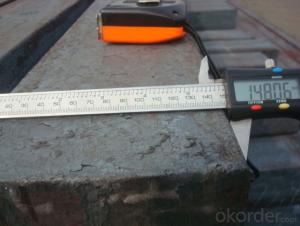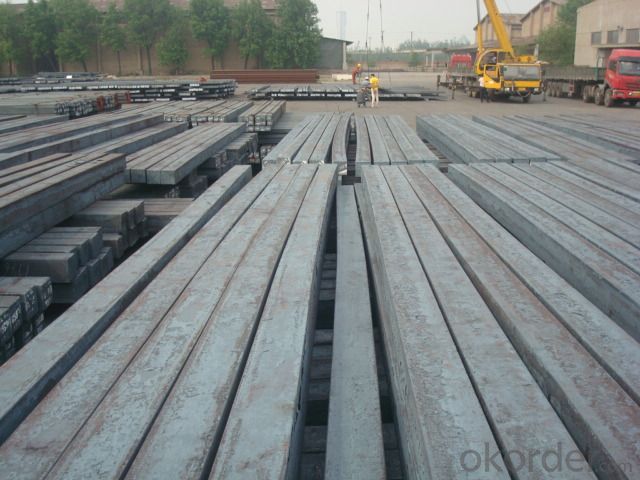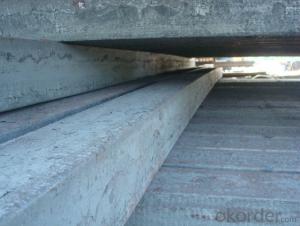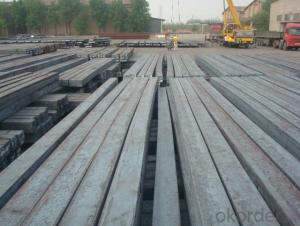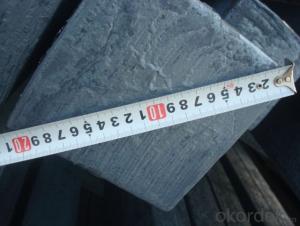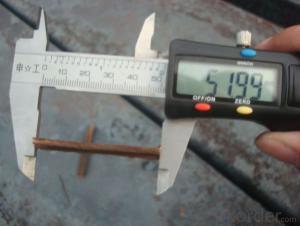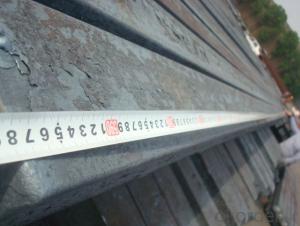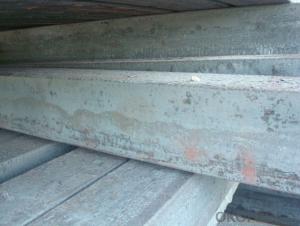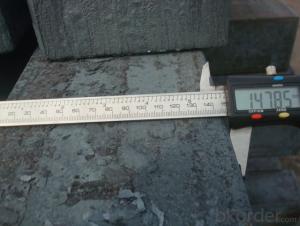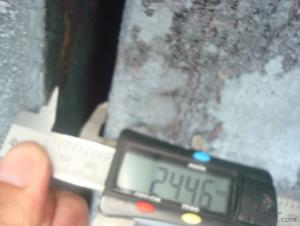Steel Billet/Bloom Made by Continue Casting Blast Furnace
- Loading Port:
- Tianjin
- Payment Terms:
- TT OR LC
- Min Order Qty:
- 1000 m.t.
- Supply Capability:
- 10000 m.t./month
OKorder Service Pledge
OKorder Financial Service
You Might Also Like
Steel Billet/Bloom Made by Continue Casting Blast Furnace
1.Structure of Steel Billet/Bloom Made by Continue Casting Blast Furnace
Steel Billet/Bloom Made by Continue Casting Blast Furnace is the raw material of all kinds of steel mill. Billet section of square, round, flat, rectangular and abnormity, etc Several, mainly related to shape of rolled products. Simple rolled section steel, choose cross section of square billet or rectangular billet. rolling The sector products such as flat steel, Angle steel, select the rectangular billet or slab. Had better profiled billet when production beams, channels, and in rolling process Lines and improve the yield. The raw material of round billet is the production of seamless tube.
2.Main Features of Steel Billet/Bloom Made by Continue Casting Blast Furnace.
Steel Billet/Bloom Made by Continue Casting Blast Furnace section size should meet the requirements of rolling deformation and finished product quality, but also roll strength and biting condition of restrictions. General steel Billet section height H. And the roll diameter D The ratio of the ( namely H/D) Should be less than or equal to zero 0.5 . Length of steel billet by finishing temperature, Rolling time and the length of the product Or times ruler. When heated too long accident prone to bump the furnace wall of steel, too short, furnace bottom utilization rate is not high, influence the heating furnace production. For the production Choose a variety of steel and steel billet, should consider the affinities of billet, as far as possible in order to improve the productivity of the roughing mill, simplify the stock management of workshop.
There are three shapes of the steel billets: square billet, slab, rectangular billet The Chinese billet, rectangular billet is mainly suitable for rolling hot rolled strip, building reinforced bar, Ordinary wire, high speed wire rod and various small profile. Of the slab are mainly used for rolling plate and hot coil sheet.
3. Steel Billet/Bloom Made by Continue Casting Blast FurnaceImages
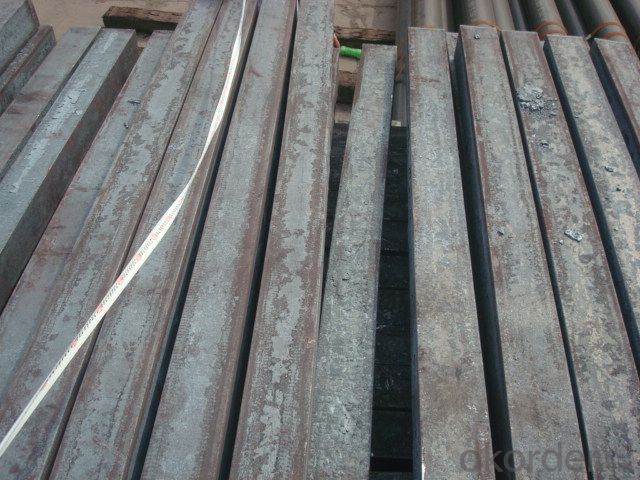
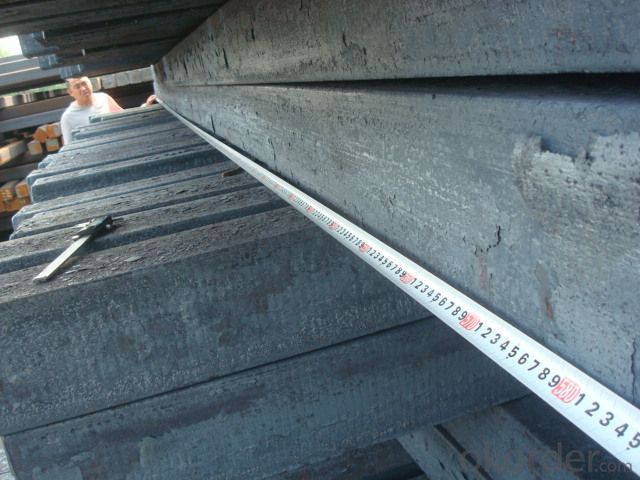
4. Steel Billet/Bloom Made by Continue Casting Blast FurnaceSpecification
Steel Billet/Bloom Made by Continue Casting Blast FurnaceMaterial standard The editor Range of thickness: 150-240 - mm + / - 5 mm width range: 880-1530 - mm + / - 20 mm Length: 3700-10000 - mm + / - 500 - mm Cross-sectional size: 64 * 64; 82 * 82; 98 * 98; 124 * 124; 120 * 150; 152 * 164; 152 * 170 mm Length: 9000 mm Section of tolerance: billet: 1.0 + / - 2.0-1.0 + / - 1.0 mm slab: width: + / - 2.0 mm thickness: + / - 3.0 mm The length tolerance: + / - 200 mm Section diagonal tolerance: 3.5-8.0 MM Billet section size protrusions requirements: < 1242 mm, do not allow; > = 1242 mm, < = 2 mm 1242 mm, < = 3 mm Beheading (shear) extension deformation: < 1242 mm billet: no control; The slab: < = 15 mm Surface tilt: no more than billet section 0.1 Bending: every 1 m length is not more than 10 mm The distortion: length < = 5 m, < = 11. ; The length of the < = 7.5 M, < = 5. Material % 3 sp/PS chemical composition: C Mn Si S P
5.FAQ of Steel Billet/Bloom Made by Continue Casting Blast Furnace
We have organized several common questions for our clients,may help you sincerely:
①How about your company?
A world class manufacturer & supplier of castings forging in carbon steel and alloy steel,is one of the large-scale professional investment casting production bases in China,consisting of both casting foundry forging and machining factory. Annually more than 8000 tons Precision casting and forging parts are exported to markets in Europe,America and Japan. OEM casting and forging service available according to customer’s requirements.
②How to guarantee the quality of the products?
We have established the international advanced quality management system,every link from raw material to final product we have strict quality test;We resolutely put an end to unqualified products flowing into the market. At the same time, we will provide necessary follow-up service assurance.
③How do you determine the billet section size? Determination of billet section size in addition to considering the deformation of rolled piece to have enough quantity to meet the finished productThe quality requirements, but also should consider to roll strength and rolling bite into the limitations. The deformation size has a great influence on the product performance.Can make the metal internal organization and deformationPerformance can not meet the quality requirements.Such as high speed steel must have enough deformation,The carbide networkTo be broken or heavy rail and seamlessSteel pipeBy the total elongation coefficient of steel ingot to the finished product usually must alsoGuarantee up to50). However, in the roll diameter and reduction given conditions, if the blank section size is too big, not only canCan occur due to deformation of impervious surface deformation of rolled piece,But also roll breakage happens,biteEntering the rolled piece difficult, etc., generally billet height and roll diameter has the following relationship: The H/DOr less0.49 (4 to 5) Type in theH.- height of billet,mm; D- work roll diameter,mm. type4 to 5The data is given from the guarantee roll blank section strength and bite conditions decisionThe size of the important parameters. Ingot after the blooming mill rolling into or through forging press forging into different specifications of the billet,Are all kinds of finished product rolling millThe main raw material.Cross section shape of the billet (as shown in figure4-3) there are square, rectangular and circularAnd other shapes (alien). There is a wide variety of billet section shape is the root cause of steel varieties, specifications range is very wide,Profile is varied,And with the same cross section shape of all varieties of steel billet production isNot possible.
- Q: Can steel billets be used in the production of marine equipment?
- Yes, steel billets can be used in the production of marine equipment. Steel is known for its strength, durability, and corrosion resistance, making it a suitable material for marine applications. Steel billets, which are semi-finished products in the steel manufacturing process, can be further processed and transformed into various marine equipment components such as ship hulls, propeller shafts, rudders, and offshore structures. The high strength-to-weight ratio of steel makes it ideal for handling the demanding conditions encountered in marine environments, including exposure to saltwater, extreme temperatures, and mechanical stresses. Additionally, steel can be easily fabricated, welded, and machined, allowing for the customization and production of complex marine equipment designs. Overall, steel billets are a valuable raw material in the production of marine equipment due to their strength, durability, and suitability for marine applications.
- Q: What is the average cost of steel billets?
- Several factors can influence the average cost of steel billets, including the type of steel, market conditions, and global supply and demand. Steel billets are semi-finished metal products commonly used as raw materials for various steel products. As of September 2021, the average price of steel billets ranges from $400 to $600 per metric ton. However, it is important to be aware that this price can fluctuate significantly due to factors such as changes in raw material costs (such as iron ore and scrap metal), energy prices, transportation costs, and market dynamics. Furthermore, specific countries or regions may experience variations in the average cost of steel billets due to regional factors like import tariffs, trade restrictions, and currency exchange rates. It is always recommended to seek advice from industry experts, steel suppliers, or consult market reports for the most accurate and up-to-date information on the current average cost of steel billets.
- Q: How are steel billets forged into shape?
- The process of hot forging is utilized to shape steel billets. It entails heating the billet to a temperature that enables easy manipulation, typically ranging from 1100 to 1250 degrees Celsius. Once heated, the billet is positioned on a die, which is a specially designed tool with a cavity that imparts the desired shape onto the final product. Pressure is exerted on the billet by a large mechanical or hydraulic press, compelling it to fill the die cavity. This pressure induces the steel to flow and take the shape of the die, resulting in the intended form of the forged item. Depending on the product's size and complexity, the pressure applied during forging can reach several thousand tons. Throughout the forging process, the steel billet undergoes plastic deformation, causing its internal structure to rearrange and the metal grains to align. This grain alignment enhances the mechanical properties of the forged product, increasing its strength and durability. To achieve the final dimensions and features, additional operations such as trimming, piercing, or punching may be conducted after the initial shaping. These post-forging operations can be carried out while the steel is still hot or after it has cooled down. Once the desired shape is attained, the forged product is slowly cooled to alleviate any residual stresses and prevent cracking. This cooling process, known as annealing, enhances the metallurgical properties of the steel and improves its overall performance. To summarize, the hot forging process involves heating the steel billet, placing it on a die, applying high pressure to shape it, and subsequently cooling it to optimize its mechanical properties. This process enables the transformation of steel into various intricate shapes, making it a versatile and extensively used material across multiple industries.
- Q: What are the specifications for stainless steel billets used in the food industry?
- To ensure safety and hygiene, the food industry requires stainless steel billets to meet specific specifications. These specifications focus on the stainless steel's composition, corrosion resistance, and ability to withstand high temperatures and aggressive cleaning agents. First and foremost, stainless steel used for food industry billets must contain a high percentage of chromium, typically ranging from 16% to 18%. This high chromium content ensures excellent corrosion resistance, preventing any reaction with food or cleaning agents. In addition, these billets should have a low carbon content, usually below 0.08%. By keeping the carbon content low, the stainless steel becomes less susceptible to sensitization, which can cause corrosion and contamination of food products. Furthermore, the stainless steel billets must adhere to specific international standards, such as ASTM A276 or EN 10088. These standards outline the minimum requirements for chemical composition, mechanical properties, and surface finish. Moreover, the surface finish of the billets is crucial in the food industry. It must be smooth and free from defects like pits or cracks to prevent the accumulation of bacteria and facilitate easy cleaning. The dimensions of the billets also contribute to their suitability for the food industry. They are commonly available in square or rectangular shapes, with various sizes depending on the specific application. Lastly, these billets should be certified and compliant with industry regulations, such as those set by the Food and Drug Administration (FDA) or the European Food Safety Authority (EFSA). In conclusion, stainless steel billets used in the food industry must meet specific requirements regarding chromium and carbon content, international standards, surface finish, dimensions, and industry regulations for safety and hygiene.
- Q: What shape is the billet?
- Steel billet is a product made by steel-making furnace by casting. The billet can be divided into two kinds from the manufacturing process, mould blank and continuous casting billet. At present, the casting process has been basically eliminated.classification
- Q: Are steel billets used in the manufacturing of industrial machinery?
- Yes, steel billets are commonly used in the manufacturing of industrial machinery. Steel billets are semi-finished products that are typically produced through a process called continuous casting. These billets serve as the raw material for various types of machinery, including heavy-duty equipment, construction machinery, and machine tools. Steel is a preferred choice for industrial machinery due to its strength, durability, and resistance to wear and tear. Steel billets are often used as the starting material for forging, rolling, or machining processes to create the specific components required for industrial machinery. These components can include gears, shafts, frames, brackets, and other structural parts. The high-quality properties of steel, such as its high tensile strength and excellent mechanical properties, make it an ideal material for withstanding the demanding conditions and heavy loads that industrial machinery is subjected to. Additionally, steel's ability to be easily welded and machined allows manufacturers to produce complex and precise parts for industrial machinery. Overall, steel billets play a crucial role in the manufacturing of industrial machinery, providing the necessary raw material to create strong and reliable components that can withstand the rigors of various industrial applications.
- Q: How are steel billets used in the production of industrial valves?
- Steel billets are an essential component in the production of industrial valves. These billets serve as the raw material for manufacturing valve bodies, which are the main structural component of the valve. To begin the production process, steel billets are first heated to a specific temperature, usually through the use of a furnace. This heating process is crucial as it allows the billets to be malleable and easily shaped into the desired valve body design. Once the billets reach the required temperature, they are transferred to a special machine called a forging press. In the forging press, immense pressure is applied to the heated billet, causing it to take on the shape of a valve body. This process, known as forging, ensures that the valve body is strong, durable, and able to withstand the high pressures and temperatures of industrial applications. After the forging process, the valve bodies are then machined to achieve the final shape and dimensions. This involves using cutting tools to remove any excess material and refine the surface finish. The machined valve bodies are then inspected for quality assurance to ensure they meet the required specifications and standards. Once the valve bodies are ready, they undergo additional processes such as heat treatment and surface coating to enhance their strength, corrosion resistance, and overall performance. These treatments help to ensure that the valves can withstand harsh operating conditions and have a long service life. In summary, steel billets play a critical role in the production of industrial valves. They are heated and forged to create the valve bodies, which form the structural foundation of the valves. Through additional machining, heat treatment, and surface coating processes, the billets are transformed into high-quality valves that can effectively control the flow of fluids or gases in various industrial applications.
- Q: How does billet caster pull out billet cracking?
- The strict two cooling water distribution system, the degree of purification of the molten steel, and the precise arc are related!
- Q: What are the different international trade regulations for steel billets?
- There are several international trade regulations that govern the trade of steel billets. These regulations aim to promote fair trade practices, ensure product quality, and prevent unfair competition. Some of the key regulations for steel billets include: 1. Tariffs and duties: Many countries impose tariffs or import duties on steel billets to protect domestic steel industries. These tariffs can vary significantly between countries and may change periodically. Importers and exporters need to be aware of these tariffs and factor them into their pricing and cost calculations. 2. Anti-dumping measures: Anti-dumping regulations are in place to prevent the sale of steel billets in foreign markets at prices lower than their production cost, which can harm domestic industries. If a country determines that steel billets are being dumped into their market, they may impose anti-dumping duties or other measures to address the issue. 3. Trade agreements and trade barriers: International trade agreements, such as free trade agreements or regional trade blocs, can affect the trade of steel billets. These agreements may reduce or eliminate tariffs and other trade barriers between participating countries, promoting smoother trade flows. Conversely, countries not party to such agreements may face higher trade barriers, making it more challenging to export or import steel billets. 4. Quality and safety standards: Steel billets must meet specific quality and safety standards set by importing countries. These standards may include specifications for dimensions, chemical composition, mechanical properties, and other attributes. Importers and exporters need to ensure their steel billets comply with these standards to avoid rejection or additional inspection upon arrival. 5. Export controls: Some countries impose export controls or restrictions on certain goods, including steel billets, to ensure domestic supply or protect national security interests. These controls can limit the quantity or destination of steel billet exports, requiring exporters to obtain licenses or permits before shipping. 6. Documentation and customs requirements: International trade of steel billets requires proper documentation and adherence to customs procedures. Exporters must provide accurate and complete documentation, including commercial invoices, packing lists, certificates of origin, and other relevant documents. Importers must comply with customs requirements and pay any applicable duties or fees. It is essential for businesses involved in the trade of steel billets to stay informed about these international trade regulations. They should regularly monitor changes in tariffs, anti-dumping measures, trade agreements, and quality standards to ensure compliance and make informed business decisions.
- Q: What is Alfa carbon? What is beta carbon?
- Alfa is directly connected with the functional groups of carbon atoms of carbon atoms, such as CH3CH2COOH CH2 in which methylene propionate is Alfa carbon carbon carbon atom is the beta carbon atom is directly connected with the functional groups and the connection of the carbon (around Kazakhstan), such as the CH3CH2COOH CH3 propionic acid methyl carbon is the beta carbon
Send your message to us
Steel Billet/Bloom Made by Continue Casting Blast Furnace
- Loading Port:
- Tianjin
- Payment Terms:
- TT OR LC
- Min Order Qty:
- 1000 m.t.
- Supply Capability:
- 10000 m.t./month
OKorder Service Pledge
OKorder Financial Service
Similar products
Hot products
Hot Searches
Related keywords
